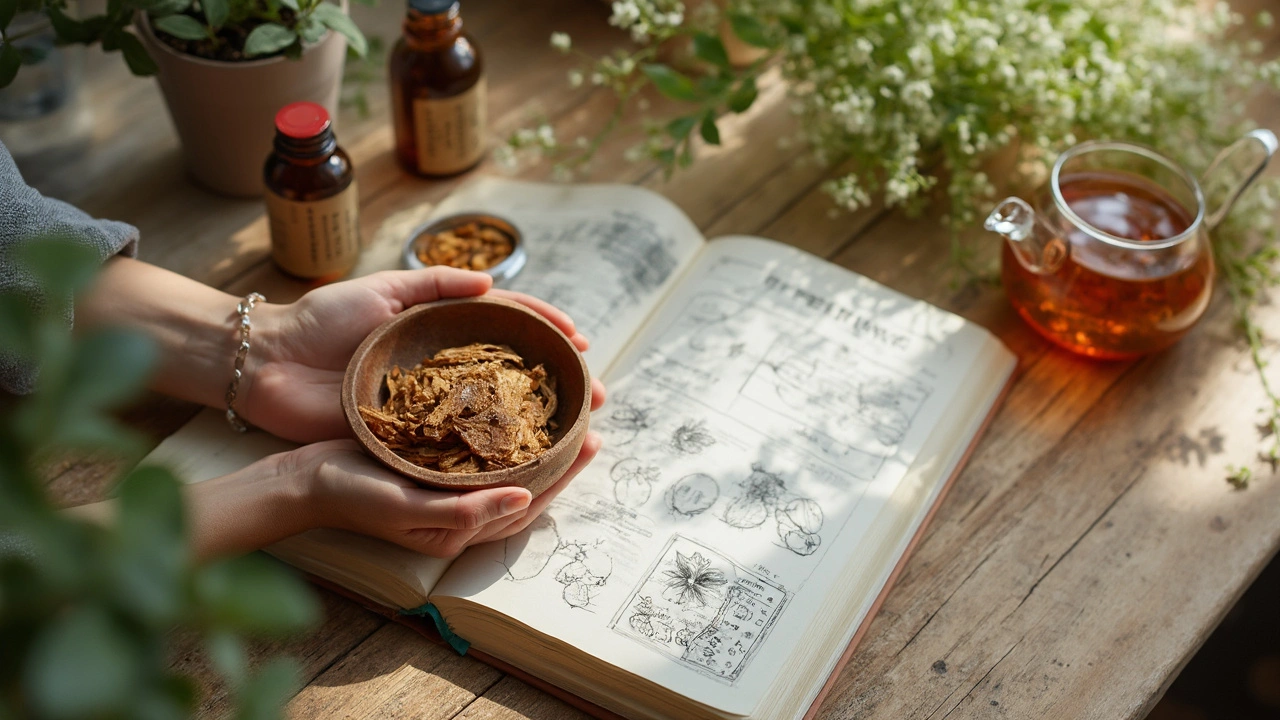Pao Pereira: Different Forms and the Best Ways to Take It
Let’s get straight to it: if you walk into a supplement shop or surf the web long enough, you’ll stumble across Pao Pereira—this tough-skinned, rainforest tree bark with a track record that goes way back in Amazonian traditions. It’s not the kind of stuff you just tear off a tree and chew, so product form makes a world of difference. The most common varieties you’ll see are capsules, tablets, powders, liquid extracts, and even teas. Each one has a different feel, taste, and way of fitting into your daily routine. Some people prefer the ease of swallowing a capsule before breakfast, while others get a little ritual out of mixing powder into their morning shake or a cup of soothing tea after dinner.
Capsules are super convenient—no taste and easy to travel with. This is the typical go-to if you want precise dosing without the mess. Powders, on the other hand, let you control how much you’re getting, but there’s a catch. Raw Pao Pereira bark tastes earthy, sometimes described as a mix between cedarwood and unsweetened cocoa. My wife Diana pulled a face the first time I tried mixing it into a smoothie, but with the right fruits or yogurt, you barely notice. Tea is old-school, and fans swear by the slow simmer to draw out the bark’s signature alkaloids. Sure, it takes more effort than popping a capsule, but there’s something grounding about unwinding at night with a cup steeped with a bit of rainforest mystery.
Liquid extracts are an option if you want max potency in a tiny dropper bottle. Just know: the flavor can be tough to mask. Some liquid forms come mixed with other herbs, so check labels closely. For new users, starting with capsules or tablets keeps things predictable, but if you’re an experimenter with a strong stomach, the powders and teas let you tinker until you find your sweet spot. Whichever path you choose, the basic rule is always the same—listen to your body the first few days. Don’t overdo it or think, “If a little is good, a lot must be better.” It just doesn’t work that way with herbal supplements, and your stomach will let you know if you misstep.

Finding Your Dosage: How Much Is the Right Amount?
Dosing with Pao Pereira is not like counting out your morning allergy meds. It’s still treated as a supplement, not a drug, so you won’t see most official bodies handing out daily recommended limits. What you can rely on, though, are common sense rules that most reputable manufacturers follow. Most capsules have somewhere between 200mg to 500mg of standardized bark extract per pill, and suggested serving sizes hover around two to four capsules a day for adults. My buddy tried jumping in with a mega-dose his first week and wound up with a sour stomach—your gut’s the best early warning system for dialing things back a notch.
If you’re using powder, the usual scoop range lands between 1 and 3 grams per day, split into morning and evening servings. Liquid extracts are concentrated, so read the label; you’ll often see a range like 2 to 4 droppers (about 80 to 160 drops) a day, split into two or three doses. Don’t be alarmed if you run into brands that list “Alkaloid content” on their packaging. That’s just their way of showing how much of the active compounds are inside—nitidine, flavopereirine, and others are the key players. Manufacturers who standardize their extracts help you know you’re not just getting ground-up bark but a steady punch of what’s been studied the most.
But what if you’re new to supplements, or you’re already taking meds for other stuff? Here’s where good judgment pays off. Start with the lowest listed dose, stay there for a week, and pay attention to how you feel. Check in with your doctor or a good naturopath before mixing any herbal supplement with prescriptions for blood pressure, blood thinners, or immune conditions—these are common crossovers that get folks into trouble when they skip the consult. If you’ve heard about the bark because you’re interested in what is Pao Pereira used for, then you’ll know folks take it for all sorts of reasons—supporting immune function, fighting fatigue, or even just curiosity. Still, precise dosing is personal, not one-size-fits-all. Even my teenage daughter Sadie, who’s about as tall as her little brother Oliver now, would need only a tiny fraction of what most adults can tolerate—assuming our family doctor gave the okay. The bottom line is, everyone’s response is a bit unique, and you won’t know until you actually try it. Journal your doses and how you feel; it doesn’t have to sound scientific. “Took 1 capsule at lunch, felt normal.” That sort of low-stress tracking pays off if you ever need to troubleshoot later.

How to Know If Your Pao Pereira Is High Quality
This is where it really matters, because quality makes a world of difference—cheap fillers won’t just waste your money, they can actually be risky. If a brand is selling capsules stuffed with extra “plant starches” instead of pure Pao Pereira extract, you won’t get any of the supposed benefits. Reputable companies will show testing results for heavy metals, pesticides, and microbial contamination. Fancy term? Don’t worry—it just means they checked the product to make sure there’s nothing but what you paid for inside. If you can’t find a batch number and a QR code that leads to a lab report, you’re rolling the dice.
Here’s a checklist you can use:
- Check for clear labeling—Latin name (Geissospermum vellosii or simiarum), standardization details, batch numbers, and expiration dates.
- Does the brand publish third-party lab testing? If not, send them a message or skip to the next supplier.
- Look for certified organic sources or phrases like "wild-harvested," especially if you’re picky about pesticide exposure.
- Scour ingredient lists for sneaky fillers: magnesium stearate, maltodextrin, or “proprietary blends” without transparency.
- Stick to brands with a solid reputation—if their contact page just lists a random Gmail address, take the hint.
One thing you’ll notice? High-quality Pao Pereira is never dirt cheap. It takes a lot of bark, careful drying, and low-heat extraction to pull out the active compounds, and it’s rare enough that bargain bin deals usually mean you’re either getting old stock or sawdust. If you shop online, give the review section a good skim. Watch out for reviews that all sound the same or use the same wording—real customers talk about the smell, taste, and how it mixes, not just “Great supplement, would buy again!”
For the curious, a few supplement brands go an extra step and tell you exactly which region of the rainforest their bark comes from. That bit of traceability is golden. You may also spot a "certificate of analysis" (COA) that breaks down purity and potency in numbers—those are keepers. Double-check storage advice, too; Pao Pereira doesn’t love damp kitchens or hot window ledges. I learned the hard way after Bob the beagle got his nose into an old bottle we left out, and let’s just say it was a long afternoon.
What about scammers and counterfeits? It happens more than you’d think, especially as Pao Pereira’s picked up media attention. Trust your gut—if a seller promises instant, miracle results or dodges direct questions about sourcing, hit the brakes. When you find a good supplier, hang onto them. Stock up on a batch or two, but avoid hoarding to the point that the product sits and degrades—fresh is always best with botanical supplements. Sticking to these rules means you get what you pay for, whether you’re new to Pao Pereira or just want reliable results batch after batch.


Comments
Mina Berens
Wow, this guide on Pao Pereira bark is super helpful! 🌿 I’ve been curious for a while but totally lost about which form to get or how much to take. It’s refreshing to see advice that’s straightforward and doesn’t try to sell you something right away.
One thing I’ve always wondered is if capsules are better than tinctures or powders when it comes to absorption? Also, quality advice is gold because there’s so much sketchy stuff out there. Thanks for making it easy for those of us who are new to this.
Has anyone here had experience with brands that stood out for their quality? Would love some recommendations. 😊
July 18, 2025 AT 07:05
Geneva Lyra
Oh, yes! I agree, it’s soooo important to know exactly what you’re buying and how to use it safely. I’ve tried a couple of supplements before and sometimes it’s just confusing with all the jargon and labels.
Plus, not every product from the Amazon is sustainable or well-sourced, so we gotta be mindful of that too. I like the tip about spotting trustworthy brands! 😅
If more people could share their experiences, maybe we could put together a little trusted list of sellers? That way no one gets scammed or ends up with low-quality stuff.
July 21, 2025 AT 12:38
Moritz Bender
From a biochemical standpoint, Pao Pereira contains multiple alkaloids that may impact cellular metabolism. When considering forms, extracts tend to have higher bioavailability compared to raw bark powders. Capsules often deliver standardized dosages, but tinctures can provide quicker absorption via mucosal membranes.
Quality control includes verifying phytochemical assays and third-party testing for contaminants. Beware of unregulated sources that could be adulterated or mislabeled. Dosage should begin conservatively—typically 200-400mg daily—while monitoring for any adverse reactions.
Anyone here interested in diving deeper into the pharmacodynamics? I’m happy to share studies!
July 24, 2025 AT 01:08
Nicole Hernandez
This guide really sparks my curiosity about how traditional Amazonian medicines are finding their place in modern wellness. It’s fascinating to think about integrating nature’s remedies with contemporary health approaches.
I wonder what cultural context surrounds the original use of Pao Pereira bark in its native regions? Understanding that might help us approach it with more respect and mindfulness.
Also, I appreciate the encouragement to avoid mistakes. Too often, people just jump in without proper research and end up disappointed or worse.
July 27, 2025 AT 18:52
Anthony Coppedge
I want to highlight the importance of precise orthography and clear communication when people discuss medicinal supplements. Misinterpretation of dosage instructions can lead to serious health risks.
Furthermore, skepticism is valuable, but it shouldn't prevent open-mindedness toward alternative remedies. It's all about balance and verifying sources meticulously.
Can we also agree that user reviews, while helpful, must be approached critically? Anecdotal evidence can be biased or incomplete.
July 29, 2025 AT 13:38
Emily Moody
Honestly, I think people don’t appreciate enough the sheer magnitude of the Amazon’s botanical treasures. The Pao Pereira bark is just one of many marvels that have the potential to transform how we view health.
The narrative around supplements often feels so bland and sanitized. This guide starts to scratch the surface with some good tips, but there’s a whole world of vibrant, complex knowledge here.
Imagine embracing the intensity of indigenous wisdom with the precision of modern science—it’s a match made in heaven for holistic healing!
August 2, 2025 AT 08:45
Prateek Kohli
I love seeing posts like this from a global perspective. The Amazonian remedies are exceptional, and the key is respecting their origins and understanding how they fit into various wellness frameworks worldwide.
Personally, I use Pao Pereira tincture occasionally for its antioxidant properties, and I’ve found it to be quite effective when taken with a balanced diet and mindfulness practices. 😊
It’s really helpful to chat with others here about safe dosages and trusted suppliers to keep things sustainable and effective.
August 4, 2025 AT 16:52
Noah Seidman
Look, I get all the enthusiasm around supplements, but please don’t fall for every trendy super-bark from the Amazon. People need to critically evaluate the science rather than just buying into mysticism or anecdotal hype.
Healthcare should be rooted in well-founded evidence, not just some internet guide that brushes over potential risks or contraindications. I don’t mean to be a downer, but it’s essential to question everything.
Does anyone here know about interactions Pao Pereira might have with common medications? Or long-term safety data? That’s what truly matters.
August 8, 2025 AT 00:18
Anastasia Petryankina
Oh, the irony of another forest miracle potion entering the wellness hype cycle. How original. 🙄 Honestly, it’s always amusing to watch how these obscure barks suddenly become the next big thing, hyped up by people who barely understand the first thing about them.
Still, gotta admit, the guide was surprisingly straightforward and lacking the usual grandiose nonsense. I guess that’s something.
Anyone else think this will be forgotten in a few months until another 'miracle' shows up?
August 11, 2025 AT 15:15
Tim Ferguson
I don’t know why people obsess over these supplements. Isn't it just nature doing what nature does? Maybe humans should chill and stop over-complicating everything for the sake of wellness trends.
That said, the guide was okay. It does its job of giving basic info without preaching. Sometimes simple is better.
Is it really worth the cost though? Curious if others here think it’s a necessity or just an overhyped addition.
August 14, 2025 AT 07:58
Noah Cokelaere
Oh yeah, because when I think about wellness, I immediately jump at the idea of grinding obscure Amazonian bark into a powder. 😏 But seriously, the guide made some good points, especially around quality and dosage.
Has anyone here actually noticed a difference after adding Pao Pereira to their routine? I'm all for natural remedies, but evidence and personal experience need to back it up.
Also, the section on spotting trustworthy brands was priceless because it’s a jungle out there (pun intended!)
August 17, 2025 AT 07:05